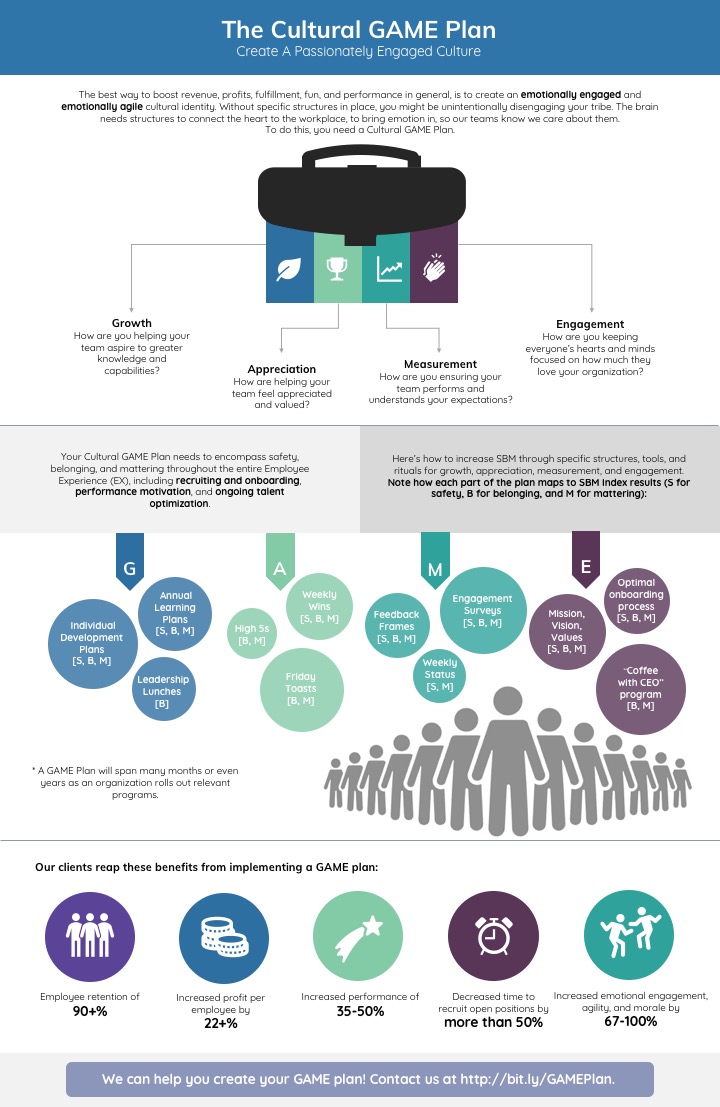

*As originally seen on Forbes.com
Are you helping your team build trust and increase emotional agility?
All leaders need a GAME plan to build sustainable tribal agility and improve company culture. But you don’t need to reinvent the wheel. I’ll provide a template in a moment!

What Is A GAME Plan?
A Cultural GAME Plan provides cultural rituals so a person knows how to stay in the tribe (be safe and belong) and gain status (matter) in each of these four key areas, which are all imperative to improve company culture. It not only establishes trust at the cultural level but it also supports a fulfilling work experience, which will yield the happiest and most committed, productive, loyal, long-term, constantly evolving emotionally agile team members. You deserve this. So do they.
GAME stands for the following:
- Growth: How are you helping your team to aspire to greater knowledge and capabilities?
- Appreciation: How are helping your team to feel appreciated and valued?
- Measurement: How are you ensuring that your team performs and understands your expectations?
- Engagement: How are you helping keep everyone’s heart and mind focused on how much they love your organization?
Your GAME Plan Recipe
1. Do an SBM Index engagement survey to find what your tribe needs to improve company culture.
2. Create your GAME Plan based on your SBM Index findings. Your Cultural GAME Plan needs to encompass safety, belonging, and mattering throughout the entire employee experience (EX), which means you’ll want to include recruiting and onboarding, performance motivation, and ongoing talent optimization. This is how so many of my clients earn Best Places to Work awards—which make a huge difference in recruiting, retention, performance, and employee happiness overall.

What you include in your plan will be customized to your needs, but here are some examples of how to increase SBM through specific structures, tools, and rituals for growth, appreciation, measurement, and engagement. Note how each part of the plan maps to SBM Index results (S for safety, B for belonging, and M for mattering):
Growth: How are you helping your team aspire to greater knowledge and capabilities?
- Individual Development Plans (S, B, M)
- Leadership Lunches (B)
- Annual (Organization-wide) Learning and Development Plans (S, B, M)
- Feedback Frames (S, B, M) [Cindy—need to link to recent feedback blog]
- Turnaround Processes (S, B, M)
Appreciation: How are you helping your team feel appreciated and valued?
- High Fives (M, B)
- Rock Star of the Month [M, B]
- Weekly Wins (S, B, M)
- Friday Toasts (M, B)
- Merit Money and/or peer-based bonus programs (B, M)
Measurement: How are you ensuring that your team performs and understands your expectations?
- Accountability Structures (S, B, M)
- Weekly Status (S, M)
- Dashboards (S, B, M)
- Performance Self-Evaluations (S, B, M)
- Engagement Surveys (such as the SBM Index) (S, B, M)
Engagement: How are you helping keep everyone’s heart and mind focused on how much they love your organization?
- Engaging mission, vision, and values statements (S, B, M)
- Impact Descriptions (S, B, M)
- Coffee with the CEO” program (B, M)
- Organization-wide contests (M, B)
- Diversity, Equity, and Inclusion Structures (S, B)
- Optimal recruiting processes (to ensure value alignment) (B)
- Optimal onboarding processes (S, B, M)
- Visual, auditory, and kinesthetic goals (goals you show that people are progressing toward V, talk about A, and anchor in an activity K) (S, B, M)
3. Implement your GAME Plan on a monthly basis. After the initial programs have been in place for six to nine months, complete a new SBM Index to assess results. A GAME Plan will span many months or even years as an organization rolls out relevant programs.
The table below shows the first month’s programs of the GAME Plan created for one of my clients, based on that organization’s SBM Index results.
| What | Why (Details) | Benefits | Owner | Budget |
| Create Culture Team | Cross-functional group of 5 people to be sounding board and support and to roll out culture programs. | Have internal champions, and avoid having programs look like they are “HR sanctioned.” | Susanna | NA |
| Draft engaging mission, vision, and values | Understand why we’re here, where we are going together, and what our tribal behavior code is. | Increased retention, engagement, intrinsic motivation, and safety, belonging, and mattering (SBM). | Tyrone | NA |
| Create High Five Program, Version 1 | Anyone can appreciate or acknowledge someone across the organization for modeling our values. Start with flip charts in the kitchen, then we can get techy later. | More belonging and mattering, values embraced more quickly. Generates good feelings about each other and organization overall. | Susanna | Need SharePoint for Version 2 |
| Weekly Wins | Celebrate the little good things that happen weekly. Provide format for leaders to use with their teams.
Submissions due to leaders by 5 p.m. Thursday. Leaders’ and talent’s rollouts and e-mails sent out each Friday by 2 p.m. |
Increased safety, belonging, and mattering. | Susanna | NA, but may use Slack in the future |
| Accountability Structures, Decision Spaces, and Weekly Status reports | Gain clarity on priorities and performance expectations. Gain visibility on dependencies and contingencies across departments. Start with Google Sheets. | Better decision- making. Everyone knows what they own and when it’s due. | Jean-Claude | NA, but may research software later |
To improve company culture, we needed to know what the organization was craving most overall, and that was belonging, so we put cultural rituals in place first to create connection and tribe. In the following months we would address safety and mattering as the experience of belonging was strengthened. In addition to the initial programs, we coached the investments leader to bring more safety to his team.
4. As you continue to implement your plan to improve company culture, you’ll enjoy increasing amounts of the benefits our clients love:
- Increased employee retention by more than 90%
- Increased profit per employee by over 22%
- Increased performance by 35% to 50%
- Increased emotional engagement, agility, and morale by 67% to 100%
- Decreased time to recruit for open positions by more than 50%
The Net-Net:
- A Cultural GAME Plan helps to improve company culture by fostering a fulfilling work experience, which yields the happiest and most committed, productive, loyal, long-term, constantly evolving, and emotionally agile team members. They will say, “I love my job, I trust my leader, and I’m ready to rock today!”
- This is true emotional agility and engagement.
________________________________________________________________________________________________

Get Neuroscience Tools,
Tips and Techniques.
Subscribe Today!





